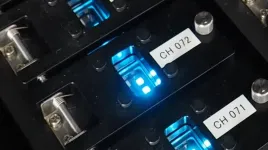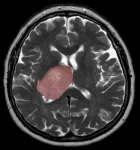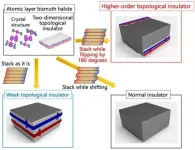(Press-News.org) Using a new combination of emitter molecules, researchers in Japan have demonstrated the promise of a novel approach to finally overcome a major challenge facing displays using organic light-emitting diodes: a blue light source matching the excellent performance of the red and green ones.
By splitting energy conversion and emission processes between two molecules, the researchers achieved devices that produce pure-blue emission with high efficiency, maintain brightness for relatively long times, and lack any expensive metal atoms--a set of properties that has so far been difficult to obtain simultaneously.
Acclaimed for their vibrant colors and ability to form thin and even flexible devices, organic light-emitting diodes, or OLEDs for short, use carbon-containing molecules to convert electricity into light.
Unlike LCD technologies employing liquid crystals to selectively block emission from a filtered backlight covering many pixels, the separate red, green, and blue emitting pixels of an OLED display can be completely turned on and off individually, producing deeper blacks and reducing power consumption.
However, blue OLEDs in particular have been a bottleneck in terms of efficiency and stability.
"A growing number of options exist for red and green OLEDs with excellent performance, but devices emitting high-energy blue light are more of a challenge, with tradeoffs almost always occurring among efficiency, color purity, cost, and lifetime," says Chin-Yiu Chan, a researcher at Kyushu University's Center for Organic Photonics and Electronics Research (OPERA) and author on the study reporting the results in Nature Photonics.
While stable blue emitters based on a process known as fluorescence are often used in commercial displays, they suffer from a low maximum efficiency. So-called phosphorescent emitters can achieve an ideal quantum efficiency of 100%, but they generally exhibit shorter operational lifetimes and require an expensive metal such as iridium or platinum.
As an alternative, OPERA researchers have been developing molecules that emit light based on the process of thermally activated delayed fluorescence, commonly abbreviated as TADF, which can achieve excellent efficiency without the metal atom but often exhibits emission containing a wider range of colors.
"The range of colors a display can produce is directly related to the purity of the red, green, and blue pixels," explains Chihaya Adachi, director of OPERA. "If blue emission is not pure with a narrow spectrum, filters are needed to improve the color purity, but this wastes emitted energy."
Takuji Hatakeyama's group at Kwansei Gakuin University recently reported a promising path to overcome the purity issue based on a unique molecular design for a highly efficient, pure-blue TADF emitter, but the molecule, named ν-DABNA, quickly degrades under operation.
Collaborating with Hatakeyama, the OPERA researchers have now found that lifetime can be greatly improved while still obtaining narrow emission by combining ν-DABNA with an additional TADF molecule developed at OPERA as an intermediate, high-speed energy converter.
"Three-fourths of electrical charges combine to form energy states called triplets in OLEDs, and TADF molecules can convert these non-emitting triplets into light-emitting singlets," explains Masaki Tanaka, an OPERA researcher who worked closely with Chan on the study.
"However, ν-DABNA is somewhat slow at converting the high-energy triplets, which often play a role in degradation. To get rid of the dangerous triplets more quickly, we included an intermediary TADF molecule that can more rapidly convert triplets into singlets."
Though the intermediary molecule is fast at converting triplets to singlets, it has a wide emission spectrum producing a sky-blue emission. Nonetheless, the intermediary can transfer many of its singlets in a high-energy state to ν-DABNA for fast and pure blue emission.
"Compared to most emitters, the wavelengths that ν-DABNA can absorb are very close to the color it emits. This unique property makes it able to receive much of the energy from the wide-emission intermediary and still emit a pure blue," says Chan.
Using this two-molecule approach, which has been termed hyperfluorescence, the researchers achieved longer operational lifetimes at high brightness than previously reported for highly efficient OLEDs having a similar color purity.
"That this kind of approach can extend the lifetime of pure-blue emission from a molecule we previously developed is really exciting," says Hatakeyama.
Adopting a tandem structure that basically stacks two devices on top of each other to effectively double the emission for the same electrical current, lifetime was nearly doubled at high brightness, and the researchers estimated that devices could maintain 50% of their brightness for over 10,000 hours at more moderate intensities.
"Though this is still too short for practical applications, stricter control of fabrication conditions often leads to even longer lifetimes, so these initial results point to a very promising future for this approach to finally obtain an efficient and stable pure-blue OLED," says Adachi.
"In the near future, I hope that blue hyperfluorescence OLEDs can replace current blue OLEDs for ultra-high-definition displays," adds Chan.
INFORMATION:
For more information about this research, see "Stable pure-blue hyperfluorescence organic light-emitting diodes with high-efficiency and narrow emission," Chin-Yiu Chan, Masaki Tanaka, Yi-Ting Lee, Yiu-Wing Wong, Hajime Nakanotani, Takuji Hatakeyama, and Chihaya Adachi, Nature Photonics (2021). https://doi.org/10.1038/s41566-020-00745-z
Babies who suffer oxygen deficiencies during birth are at risk of brain damage that can lead to developmental delays, cerebral palsy and even death. To prevent this, most women in labor undergo continuous monitoring of the baby's heart rate and receive supplemental oxygen if the heart rate is abnormal, with the thought that this common practice increases oxygen delivery to the baby. However, there is conflicting evidence about whether the long-recommended practice improves infant health.
Now, a comprehensive analysis - led by Washington University School ...
New Columbia Engineering study--first to investigate the long-term effect of soil moisture-atmosphere feedbacks in drylands--finds that soil moisture exerts a negative feedback on surface water availability in drylands, offsetting some of the expected decline
New York, NY--January 4, 2021--Scientists have thought that global warming will increase the availability of surface water--freshwater resources generated by precipitation minus evapotranspiration--in wet regions, and decrease water availability in dry regions. This expectation is based primarily on atmospheric thermodynamic processes. As air temperatures rise, more water evaporates into the air from the ocean and land. Because warmer air can hold more water vapor than dry air, a more humid atmosphere ...
ANN ARBOR, Michigan -- Michael Green, M.D., Ph.D., noticed that when his patients had cancer that spread to the liver, they fared poorly - more so than when cancer spread to other parts of the body. Not only that, but transformative immunotherapy treatments had little impact for these patient.
Uncovering the reason and a possible solution, a new study, published in Nature Medicine, finds that tumors in the liver siphon off critical immune cells, rendering immunotherapy ineffective. But coupling immunotherapy with radiotherapy to the liver in mice restored the immune cell function and led to better outcomes.
"Patients with liver metastases receive little benefit from immunotherapy, a treatment that has been a game-changer for many cancers. Our research suggests ...
MADISON, Wis. -- Deforestation dropped by 18 percent in two years in African countries where organizations subscribed to receive warnings from a new service using satellites to detect decreases in forest cover in the tropics.
The carbon emissions avoided by reducing deforestation were worth between $149 million and $696 million, based on the ability of lower emissions to reduce the detrimental economic consequences of climate change.
Those findings come from new research into the effect of GLAD, the Global Land Analysis and Discovery system, available on the free and interactive ...
COLUMBUS, Ohio - Scientists have developed a machine-learning method that crunches massive amounts of data to help determine which existing medications could improve outcomes in diseases for which they are not prescribed.
The intent of this work is to speed up drug repurposing, which is not a new concept - think Botox injections, first approved to treat crossed eyes and now a migraine treatment and top cosmetic strategy to reduce the appearance of wrinkles.
But getting to those new uses typically involves a mix of serendipity and time-consuming and expensive randomized clinical trials to ensure that a drug deemed effective for one disorder will be useful as a treatment for something else.
The Ohio State University researchers ...
The healing process that follows a brain injury could spur tumour growth when new cells generated to replace those lost to the injury are derailed by mutations, Toronto scientists have found. A brain injury can be anything from trauma to infection or stroke.
The findings were made by an interdisciplinary team of researchers from the University of Toronto, The Hospital for Sick Children (SickKids) and the Princess Margaret Cancer Centre who are also on the pan-Canadian Stand Up To Cancer Canada Dream Team that focuses on a common brain cancer known as glioblastoma.
"Our data suggest that the right mutational change in particular cells in the brain could be modified by injury to give rise to a tumour," says Dr. Peter Dirks, Dream ...
Spintronics refers to a suite of physical systems which may one day replace many electronic systems. To realize this generational leap, material components that confine electrons in one dimension are highly sought after. For the first time, researchers created such a material in the form of a special bismuth-based crystal known as a high-order topological insulator.
To create spintronic devices, new materials need to be designed that take advantage of quantum behaviors not seen in everyday life. You are probably familiar with conductors and insulators, which permit and restrict the flow of electrons, respectively. ...
Some racial and ethnic groups suffer relatively more often, and fare worse, from common ailments compared to others. Prostate cancer is one disease where such health disparities occur: risk for the disease is about 75 percent higher, and prostate cancer is more than twice as deadly, in Blacks compared to whites. Yet whites are often overrepresented as research participants, making these differences difficult to understand and, ultimately, address.
With this problem in mind, scientists at the USC Center for Genetic Epidemiology and the Institute for Cancer Research, London, ...
Last year, more than fifty years after initial theoretical proposals, researchers in Pisa, Stuttgart and Innsbruck independently succeeded for the first time in creating so-called supersolids using ultracold quantum gases of highly magnetic lanthanide atoms. This state of matter is, in a sense, solid and liquid at the same time. "Due to quantum effects, a very cold gas of atoms can spontaneously develop both a crystalline order of a solid crystal and particle flow like a superfluid quantum liquid, i.e. a fluid able to flow without any friction" explains Francesca Ferlaino from the Institute for Quantum Optics and Quantum Information of the Austrian Academy of Sciences and the Department of Experimental Physics at the ...
Research from the University of Kent's Durrell Institute of Conservation and Ecology (DICE) has found that elephant ivory is still being sold on the online marketplace eBay, despite its 10-year-old policy banning the trade in ivory.
The trafficking of wildlife over the internet continues to be a problem, with the detection of illegal activity being challenging. Despite efforts of law enforcement, the demand for illegal wildlife products online has continued to increase. In some cases vendors have adopted the use of 'code words' to disguise the sale of illicit items.
Sofia Venturini ...






